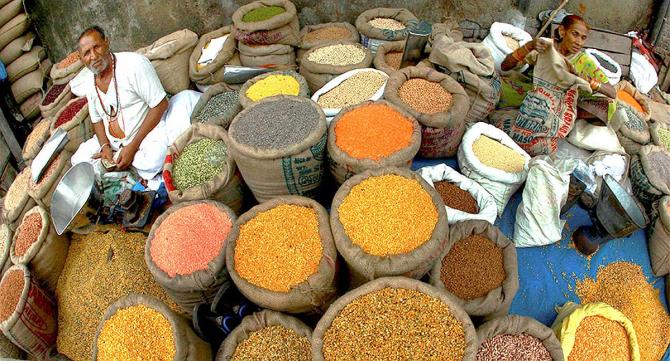After a steady surge, prices of pulses, except those of urad and masoor to some extent, are showing signs of stabilising amid a revival of monsoon rains over major growing areas of Maharashtra and Karnataka, and on expectations of a rise in imports.

Chana prices, which too had moved up in recent months, have dropped by almost 3 per cent since the end of August due to increased liquidation of government stocks, official data shows.
Monsoon rains seem to have benefitted the standing soybean crop as well.
Indore-based Soybean Processors Association of India (SOPA) said that the overall condition of the crop was normal after the recent bout of widespread rains over most parts of soybean-growing areas in the country (mainly Madhya Pradesh and Maharashtra).
However, in the case of pulses, market players are apprehensive as to how long the favorable market conditions will last, because the overall sowing of tur and urad is less than last year while festival demand is just around the corner.
“I feel prices of pulses might stay volatile for some more time due to demand and supply pulls and pressure.
"On the one hand demand could rise due to festivals, on the other hand supplies are also expected to improve due to the import of 300,000-400,000 tonnes of tur and the harvest of new crop,” Rahul Chauhan, commodity analyst at iGrain India, said.
The latest data from the department of agriculture shows that till September 8, the area under tur in this kharif season was around 269,000 hectares less than last year, while urad acreage was down by 518,000 hectares.
The area under moong was down by 256,000 hectares this year compared to the same period last year.
Overall, pulses have been sown in around 11.99 million hectares this season -- 8.5 per cent less than the same period last year.
Low rains in main growing areas of Karnataka and Maharashtra has been the main reason for this drop in acreage.
In its latest forecast, the India Meteorological Department (IMD) said that active monsoon conditions were likely over east India on September 14 and 15, over central India from September 14 to 17, and over west India from September 15 to 18.
Meteorologists said the country had received around 6 per cent lesser rainfall than the long-period average during September 1-13.
This is a big improvement from the almost 37 per cent deficiency in rains in August.
Overall, in the season -- from June 1 to September 14 -- the southwest monsoon has been 10 per cent below normal, according to the IMD data.
On soybean, SOPA said the long dry spell of 15 to 20 days in August resulted in moisture stress and some crop damage in around 15 per cent of the total sown area, particularly in places where the crop had been sown in light and sandy soil.
In these areas, the yield could also be impacted because of small grain size and poor pod formation, while insect and disease attack due to high temperature may cause some loss, the association said.
Some of the districts where minor crop damage was seen are Mandsaur, Neemuch, Ratlam, Khandwa, Dewas, Khargone and Badwani in Madhya Pradesh; Kota, Pratapgarh, Baran and Jhalawar in Rajasthan; and Beed, Osmanabad, Parbhani, Nanded, Akola, Amrawati, and Yewatmal in Maharashtra, it said.
Soybean has been sown in 12.23 million hectares this year.
(With inputs from Akshara Srivastava)











